Mark V tank
The British Mark V tank[note 1] was an upgraded version of the Mark IV tank. It was first deployed in 1918, used in action during the closing months of World War I, and in the Allied intervention in the Russian Civil War on the White Russian side, and by the Red Army, after they were captured.[5] The tank was improved in several aspects, chiefly the new steering system and engine, but it fell short in other areas such as mechanical reliability and its insufficient ventilation.[6] However, the Mark V was successful, especially given its limited service history, and primitive design.
| Mark V tank | |
|---|---|
_tank.jpg) A British Mark V (Male) tank | |
| Type | Tank |
| Place of origin | United Kingdom |
| Service history | |
| In service | 1918 – (last known) 1945[1][2] |
| Wars | First World War Russian Civil War Second World War (minimal) |
| Production history | |
| Designer | Major Walter Gordon Wilson |
| Designed | 1917 |
| Manufacturer | Metropolitan Amalgamated Railway Carriage and Wagon Company Ltd., Birmingham, UK. |
| Produced | 1917 – June 1918 |
| No. built | 400 |
| Specifications | |
| Mass | Male: 29 tons "battle weight" Female: 28 tons[3] |
| Length | 26 ft 5 in (8.5 m)[3] |
| Width | Male: 13 ft 6 inch[3] Female: 10 ft 6 in |
| Height | 2.64 m (8 ft 8 in)[4] |
| Crew | 8 (commander, driver, and six gunners) |
| Armour | 16 mm (0.63 in) maximum front 12 mm sides 8 mm roof and "belly"[3] |
Main armament | Male: Two 6-pounder (57-mm) 6 cwt QF guns with 207 rounds; |
| Engine | 19 litre six cylinder in-line Ricardo petrol engine 150 hp (110 kW) at 1200 rpm |
| Power/weight | Male: 5.2 hp/ton[3] |
| Transmission | 4 forward 1 reverse, Wilson epicyclic in final drive |
| Fuel capacity | 93 imperial gallons (420 l)[3] |
Operational range | 45 mi (72 km) radius of action[3] about 10 hours endurance |
| Maximum speed | 5 mph (8.0 km/h) maximum |
Steering system | Wilson epicyclic steering |
History
The Mark V was, at first, intended to be a completely new design of tank, of which a wooden mock-up had been completed; however, when the new engine and transmission originally planned for the Mark IV became available in December 1917, the first, more advanced Mark V design was abandoned to avoid disrupting production.[5] The designation "Mark V" was switched to an improved version of the Mark IV, equipped with the new systems. The original design of the Mark IV was to have been a large improvement on the Mark III, but had been scaled back due to technical delays. The Mark V thus turned out very similar to the original design of the Mark IV – i.e. a greatly modified Mark III.[1]
Production of the Mark V started at Metropolitan Carriage and Wagon at the end of 1917; the first tanks arrived in France in May 1918. Four hundred were built, 200 Males and Females; the "Males" armed with 6-pounder (57 mm) guns and machine guns, the "Females" with machine guns only. Several were converted to Hermaphrodites (sometimes known as "Mark V Composite") by fitting one male and one female sponson. This measure was intended to ensure that female tanks would not be outgunned when faced with captured British male tanks in German use, or the Germans' own A7V.[1]
The Mark V was to be followed by the more advanced Tank Mark VI, but this was abandoned in December 1917, to ensure sufficient production by British, American, and French factories of the Tank Mark VIII for a planned 1919 offensive. However, the war ended in November 1918, and few Mark VIIIs would be built (most of those completed in Britain were immediately scrapped).[7] The Mark V was also the basis of the Mark IX tank, a dedicated armoured personnel carrier, but only 34 were completed by the end of the war. After the war, most of the British Army's tank units were disbanded, leaving five tank battalions equipped with either the Mark V or the Medium Mark C. The British Army's interest shifted more to lighter, faster tanks, and the Mark V was partially replaced by the Vickers Medium Mark I during the mid-1920s. The Vickers A1E1 Independent reached prototype stage in 1926, but it was abandoned for lack of funds. The remaining Mark Vs appear to have been replaced by medium tanks by the end of the decade.[8]
Modifications
In early 1917, some British tanks were tested with experimental powerplant and transmissions ordered by Albert Stern. These included petrol-electric schemes, hydraulic systems, a multiple clutch system, and an epicyclic gearbox from Major W.G. Wilson. Though the petrol-electrics had advantages, Wilson's design was capable of production and was selected for use in future tanks.[6]
The Mark V had more power (150 bhp) from a new Ricardo engine (also ordered by Stern). Use of Wilson's epicyclic steering gear meant that only a single driver was needed. On the roof towards the rear of the tank, behind the engine, was a second raised cabin, with hinged sides that allowed the crew to attach the unditching beam without exiting the vehicle. An additional machine-gun mount was fitted at the rear of the hull.[6]
Unresolved issues
The Ricardo engine was still in the centre of the crew compartment which led to miserable crew conditions from its heat output.[6] The noise also interfered with crew communication.[9]
The second problem with the Ricardo engine was related to its reliability, or lack thereof. The Ricardo engine was of a somewhat unorthodox design, but it was highly efficient and, with proper care and attention, most of the issues could be mitigated.[7] However, during combat proper maintenance, while important, was the least of the crew's concerns.
The ventilation was the area in which the Mark V suffered its largest weakness. The previous Marks I-IV drew cooling air from inside the tank, through the radiator, and then expelled the air through a vent, which provided a constant supply of moving air for the crew. In contrast, the Mark V, drew air from outside the tank, across the radiator, and then expelled the air though a vent, which left the air inside the crew compartment stagnant.[6] The only ventilation for the crew compartment, other than the driver and gunner view-ports, located on all sides of the tank, was a roof-mounted Keith fan.[7] This fan was inadequate for maintaining a stable supply of clean air for the crew of a Mark V; exhaust and gun-smoke were trapped with the crew, which caused many crewmen to grow ill and, in the most extreme cases, was enough to render them unconscious; either way the crew was practically unfit for combat within a few hours.
Variants
Mark V*
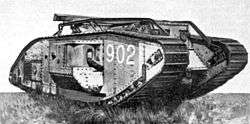
In an attempt to stop the tank threat, the German Army began digging wider trenches that made it difficult for tanks to cross. For example, trenches in the Hindenburg Line were widened to 11 or 12 feet, which was more than the British tanks' 10 feet trench-crossing ability. To counter this, Sir William Tritton developed the Tadpole Tail, an extension of the tracks to be fitted to the back of a tank, this lengthened the tank by about 9 feet. It was also hoped that this longer tank might carry a squad of infantry with Vickers or Lewis machine guns, but the conditions inside were so extreme that the men became ill, after some early experiments, and although several hundred were manufactured, the idea was abandoned. This in turn caused Major Philip Johnson of the Central Tank Corps Workshops to devise a plan of his own. He cut a Mark IV in half and inserted three extra panels, lengthening the hull by six feet. (It was believed for a long time that most Mark V* had been field conversions made by Johnson. It is now known that they were all new, factory-built to a new design). The Mark V* had a reshaped rear cupola incorporating 2 extra machine-gun mounts, a door in each side of the hull, with an extra machine-gun mount on each. This tank weighed 33 tons. The total orders for the Mark V* were 500 Males and 200 Females, 579 had been built by the Armistice – the order was completed by Metropolitan Carriage in March 1919.[10] Shortly before the end of the War, Britain supplied France with 90 Mk V*. They were not used in action, but remained in French service throughout the 1920s and 30s.
Note: the asterisk (*) in early British tank designations was usually pronounced as "star" when spoken, e.g., Mark Five-star, or Mark Five-star-star, etc.
Mark V**

Because the Mark V* had been lengthened, its original length-width ratio had been spoiled. Lateral forces in a turn now became unacceptably high causing thrown tracks and an enormous turning circle. Therefore, Major Wilson redesigned the track in May 1918, with a stronger curve to the lower run reducing ground contact (but increasing ground pressure as a trade-off) and the tracks were widened to 26.5 inches. The Mark V engine was bored out to give 225 hp and sat further back in the hull. The cabin for the driver was combined with the commander's cabin; there now was a separate machine gun position in the back. Of a revised order for 700 tanks (150 Females and 550 Males) only 25 were built and only one of those by the end of 1918.[10]
Mark V***
See: Mark X.
Combat history
The Mk V made its combat debut during the Battle of Hamel on 4 July 1918, approximately 60 tanks, many of them Mark V's, successfully supported Australian troops in an action that repaired the Australians' confidence in tanks, which had been badly damaged at Bullecourt.[11] Thereafter Mk Vs were used in eight major actions before the end of the war.
During the Battle of Amiens in August 1918, 288 Mark V tanks, along with the new Whippet and Mk V*, penetrated the German lines in a foretaste of modern armoured warfare, and signaled the end of trench warfare.
The American 301st Heavy Tank Battalion was equipped with 19 Mark V and 21 Mark V* tanks in their first heavy tank action against the Hindenburg Line on 27 September 1918. Of the 21 Mark V* tanks, 9 were hit by artillery rounds (one totally destroyed), 2 hit British mines, 5 had mechanical problems, and 2 ditched in trenches. The battalion, however, did reach its objective.
Approximately 70 Mark V tanks supplied by Great Britain to the White Russian Army and subsequently captured by the Red Army in the course of the Russian Civil War were used in 1921 during the Red Army invasion of Georgia and contributed to the Soviet victory in the battle for Tbilisi.[12]
The last confirmed use of the Mk V in battle was by units of the Red Army during the defence of Tallinn against German forces in August 1941. The four Mk Vs previously operated by Estonia were used as dug-in fortifications. It is believed that they were subsequently scrapped.[13]
In 1945, Allied troops came across two badly damaged Mk V tanks in Berlin. Photographic evidence indicates that these were survivors of the Russian Civil War and had previously been displayed as a monument in Smolensk, Russia, before being brought to Berlin after the German invasion of the Soviet Union in 1941.[1] Accounts of their active involvement in the Battle of Berlin have not been verified.[2]
Surviving vehicles
Eleven Mark V tanks survive. The majority are in Russia or Ukraine and are survivors of the tanks sent there to aid the White forces during the Russian Civil War.
- The Tank Museum, Bovington displays a Mark V Male, Number 9199. It was in action at the Battle of Amiens where its commander – Lt. HA Whittenbury – was awarded the Military Cross. It was subsequently damaged by artillery at Bellicourt in September 1918, during the Hundred Days Offensive. It has been at Bovington since 1925, and was used for demonstrations and filming.[14] While this tank is maintained in running condition, the Bovington museum had made the decision to not run it again, because of the wear and tear that would be inflicted on the now-fragile, historic vehicle.[15]
- A heavily restored Mark V Male, Devil, survives at the London Imperial War Museum. The right sponson was removed to allow a view of the tank's interior, but in the Museum's 2013 - 2014 refit the vehicle was resited in such a way that the interior is no longer visible to the public.[16]
- A Mark V Composite is at the Kubinka Tank Museum, Russia.
- A Mark V Female serves as memorial in Arkhangelsk. This was originally used by British forces during the Allied Intervention in the Russian Civil War.
- Two preserved Mark Vs, both Composites, form part of an outdoor memorial at Luhansk in Ukraine. Two more are in storage.
- A Mark V Composite is at the M. F. Sumtsov Kharkiv Historical Museum, Ukraine.
- A Mark V* Male, Number 9591, has been part of the collection of the National Armor and Cavalry Museum, Fort Benning, Georgia since 2010. Issued to Company A, US 301st Heavy Tank Battalion and hit by a 57 mm (2 in) shell round on 27 September 1918 during the attack against the Hindenburg Line, it was repaired and sent back to the United States. It is the only surviving example of the Mark V*.
- A Mark V** Female: Ol'Faithful, is also preserved at Bovington. It never saw action during the war, but post–war was fitted with hydraulic lifting gear so it could carry and deploy portable bridges, and carry out other engineering tasks. During World War 2, it was used as a ballast weight to test Bailey bridges.[17]
Gallery
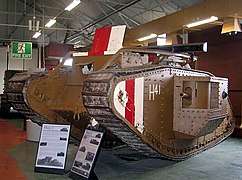 Mark V at the Tank Museum, Bovington. With vertical white-red-white British recognition stripes, still in use up to early part of World War II
Mark V at the Tank Museum, Bovington. With vertical white-red-white British recognition stripes, still in use up to early part of World War II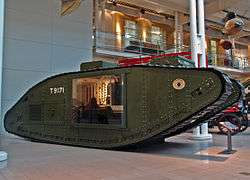 Imperial War Museum, London (2006)
Imperial War Museum, London (2006) Mark V Composite (Hermaphrodite) tank in Luhansk, Ukraine, right-hand view.
Mark V Composite (Hermaphrodite) tank in Luhansk, Ukraine, right-hand view.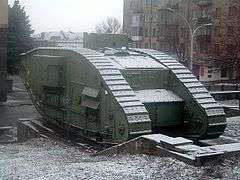 Mark V Composite (Hermaphrodite) tank in Luhansk, Ukraine, left-hand view.
Mark V Composite (Hermaphrodite) tank in Luhansk, Ukraine, left-hand view.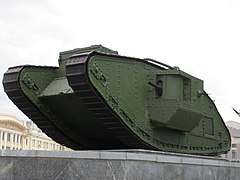 Mark V Composite tank in Kharkiv, Ukraine.
Mark V Composite tank in Kharkiv, Ukraine.- Mark V Male tank at the Imperial War Museum London.
 Mark V tank in Arkhangelsk, captured by the Red Army during the British intervention in Russia.
Mark V tank in Arkhangelsk, captured by the Red Army during the British intervention in Russia.
Notes
- Mark V = Mark 5 : Britain used Roman numerals to designate successive models of early heavy tanks
References
- Fletcher (2011) p.47
- "WW1 MK V tanks in Berlin 1945". Archived from the original on 5 January 2009.
- AFV Profile No. 3 Tanks Marks I to V
- Tank, Mark V (Male), Bovington Tank Museum
- Fletcher, David (2011). Mark V Tank. Oxford: Osprey Pub. pp. 20–28.
- Fletcher, David. "Tank Chats #21 Mark V Tank". Youtube. Retrieved 31 March 2017.
- Fuller, J.F.C. Tanks in the Great War: 1914-1918. Nashville, TN: Project Gutenberg. pp. 35–49.
- "British Tanks of the Inter-war Decades". Retrieved 13 August 2018.
- Baker, Chris. "The Tank Corps of 1914-1918". The Long Long Trail. Retrieved 31 March 2017.
- Glanfield, Devil's Chariots
- "First Battle of Bullecourt". www.awm.gov.au.
- Aksenov, A., Bullok, D (2006), Armored Units of the Russian Civil War: Red Army, p. Osprey Publishing, ISBN 1-84176-545-7
- Estonian Armoured Vehicles 1918–1940. Tiit Noormets & Mati Õun. Tammiskilp 1999. Page 94" ISBN 9789985606926
- "Tank, Mark V (Male) (E1949.327)". Bovington Tank Museum. Retrieved 28 October 2012.
- Fletcher (2013), p.153
- "Archived copy". Archived from the original on 4 March 2016. Retrieved 29 February 2016.CS1 maint: archived copy as title (link)
- "Tank, Mark V** (Female) (E1949.325)". Bovington Tank Museum. Retrieved 28 October 2012.
Bibliography
- Fletcher, David (2007). British Mark IV Tank. Osprey Publishing. ISBN 978-1-84603-082-6.
- Fletcher, David (2001). The British Tanks, 1915–19. Crowood Press. ISBN 1-86126-400-3.
- Fletcher, David. British Mark I Tank 1916. Osprey Publishing.
- Fletcher, David (2011). British Mark V Tank. Osprey Publishing. ISBN 978-1-84908-351-5.
- Fletcher, David (2013), Great War Tank Mark IV, Haynes, ISBN 978-0-85733-242-4
- Glanfield, John (2006). The Devil's Chariots. Sutton Publishing. ISBN 0-7509-4152-9.
External links
| Wikimedia Commons has media related to Mark V tank. |
- Headquarters, Tank Corps, 1 December 1917, British Army : "Instructions for the training of the Tank Corps in France". Includes Mk IV & V tank specifications.
- http://www.spartacus-educational.com/FWWmother.htm
- http://www.tankmuseum.co.uk/colww1.html
- http://www.dvinainform.ru/landoflom/2006/12/18/50915.shtml – Article on the preserved Arkhangelsk tank.
- – Lists and battle narratives of British Built Tanks in World War One.